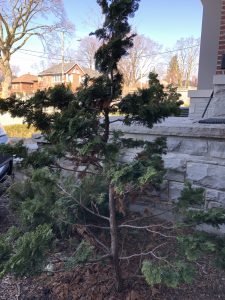
We planted 3 Hinoki cedars two springs ago. They have all now lost so many needles mostly on the inner branches they are almost bare to the tips. They face West. We have an irrigation system that waters every three days in the summer. Are they dying?
Thank you for contacting the Toronto Master Gardeners concerning your browning Hinoki cypress.
At this time of year we receive numerous questions regarding browning evergreens. During the fall we expect our deciduous trees to lose their leaves; what is surprising is that evergreens also have a tendency to shed their older interior needles. As your evergreen grows, the inner needles (which are the older needles) are shaded by new growth and as a result they become less effective at photosynthesis and eventually will fall off. The shedding of the needles varies by species and can be worse when conditions are harsh ( summer or fall drought).
The following which is from one of our earlier posts Dying and Browning Emerald Cedars provide some general gardening practices which should improve the overall health of your cypress:
“Adding a layer of mulch will hold moisture in the root zone, deter weeds and shade your cedars’ roots, and as you have done, should be kept away from the trunk of the tree. Top dressing with organic material every year is also a good practice to maintain the nutrient level of your soil.
Watering deeply and thoroughly (at least once or twice a week after planting, especially in these hot summer conditions) is key so that your cedars’ roots can take hold and spread. This is much more effective than frequent spraying or light watering, and can be done easily by using a soaker hose along the base of the cedars for several hours to ensure that the moisture reaches into the roots of the plant. Watering should continue well into the autumn until the ground is frozen to maintain adequate moisture through the winter. Cold winter winds can desiccate the foliage – once the ground is frozen, your cedars cannot take up moisture to replace what is lost from their foliage.
Deep, thorough watering can also help the roots in the root ball to separate and penetrate into the soil after planting: plants that have been in their containers for some time can often be root bound – that is, their roots circle around the pot and are quite tightly packed. If you did not loosen, tease out, or separate the roots somewhat before planting, your cedars may be experiencing some stress as the roots move into the garden soil.
Fertilizing the hedge with a 30-10-10 formulation three times in the growing season (May, June and July) is appropriate. It is very important to follow exactly the directions for applying fertilizers so that they are absorbed into the soil and are able to reach the plant’s roots. Don’t fertilize in late summer as the hedge needs to prepare to go dormant for the winter. In late fall you can fertilize with slow release nitrogen and phosphorus, which will lend the hedge a boost come spring.
Experts often recommend bone and blood meal as an alternative to another fertilizer formulation, so it is possible that the addition of a fertilizer for acid loving plants has resulted in some over-fertilization of your hedge. For more detailed information on how to fertilize, take aSh look at an earlier Q&A posted on our website, “Fertilizing cedar hedges“, which provides practical information for you.
Emerald cedars can be vulnerable to such insect pests as aphids and spider mites, and these do cause browning and death of foliage, but unless you are certain that this is occurring, the application of insecticides is not necessary; indeed, often light insect infestations can be removed with a strong spray of water, or with insecticidal soap. Here is some information on identification of and treatment for mites from another Toronto Master Garden post: https://www.torontomastergardeners.ca/askagardener/newly-planted-emerald-cedar-tree-turning-brown-from-the-outside/”
Above is a brief overview of some of the issues that may be causing your cedars to turn brown; if you search on our “Ask a Master Gardener” website using the words ‘browning cedars”, you will find several other posts answering questions on Emerald Cedars on a variety of topics which also relate to your cypress.
Good Luck

